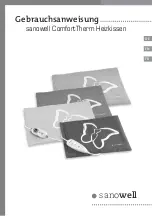
10
ASSEMBLY INSTRUCTIONS CONTINUED
Use the pressure regulator supplied with the appliance.
The installation must conform with local codes, or in the absence of local codes, with
National Fuel Gas Code, ANDZ223.1/NFPA54, Natural Gas and Propane Installation
Code, CSAB149.1, or Propane storage and handling code, B149.2.
Certain materials or items, when stored under the heater, will be subjected to radiant heat
and could be seriously damaged.
Only use a cylinder marked “propane”.
A dented, rusted, or damaged propane cylinder may be hazardous and should be checked
by your cylinder supplier. Never use a propane cylinder with a damaged valve connec-
tion.
The propane cylinder must be constructed and marked in accordance with the specifica-
tions for LP gas cylinders of the U.S. Department of Dangerous Goods and Commission,
CAN/CSA-B339.
Includes a listed overfilling prevention device.
Includes a cylinder connection device compatible with the connection for the appliance.
The cylinder used must include a collar to protect the cylinder valve.
Never connect an unregulated propane cylinder to the heater.
Move the burner control knob to the off position.
Fix the 1.02 lb. propane cylinder to the regulator
(rotate the propane cylinder clockwise toward the
regulator connecting until tight).
Close the door plate and lock it with the handle.
Disconnect the cylinder when the appliance is not
in use
Store the appliance in a shelter:
A. With walls on all sides, but with no overhead cover
B. Within a partial enclosure which includes an overhead cover and no more than two
side walls. These side walls may be parallel, as in a breezeway, or at right angles to
each other.
C. Within a partial enclosure which includes an overhead cover and three side walls, as
long as 30% or more of the horizontal periphery of the enclosure is permanently
open.
11
Use a replacement pressure regulator specified by the appliance manufacturer. Use
the pressure regulator and hose assembly supplied with the appliance.
OPERATION INSTRUCTIONS
Portable Heater Location
1. This portable heater is intended for outdoor use only. Always ensure adequate fresh
air ventilation.
2. Always maintain proper clearance to combustible materials: a minimum of 24 in.
from the top and 36 in. from the sides.
3. Place the heater on a strong and stable table.
4. Never operate the heater in an explosive atmosphere like in areas where gasoline or
other flammable liquids or vapors are stored.
Testing for Leakage
Gas connections on this heater are leak tested at the factory prior to shipment. Possible
mishandling of this appliance during shipping may impair integrity. Perform a complete
leakage test again at the installation site. Please follow the procedure below:
1. Make a soap solution of one part liquid detergent and one part water. The soap solu-
tion can be applied to hoses and connections with a spray bottle, brush, or rag.
2. Make sure that the safety control valve is in the “OFF” position.
3. Turn the cylinder valve “ON” and check for soap bubbles forming on and around
connections and hoses. If bubbles appear, there is a leak present.
4. If a leak is present, remove the gas cylinder immediately, tighten any leaking fittings,
replace the gas cylinder, and recheck.
Procedure for Leakage Test
1. Periodically check the whole gas system for leaks
2. Immediately check for leaks in an odor of gas is detected.
3. Extinguish all open flames during testing or when an odor of gas is detected.
4. Never smoke while performing the leak test,
5. If you cannot stop a leak, unscrew and remove the cylinder from the heater.
6. Check the heater with a full propane cylinder. DO NOT use the heater until you have
performed a leak test on all the connections and verified that your unit does not leak.
7. Use only manufacturer recommended replacement parts. Substitution may void the
warranty.
Do not store a spare LP-gas cylinder under or near this appliance;
Never fill the cylinder beyond 80 percent full;
Place the dust cap on the cylinder valve outlet whenever the cylinder is not in use.
Only install the type of dust cap on the cylinder valve that is provided with the
cylinder valve. Other type of caps or plugs may result in leakage of propane.




























